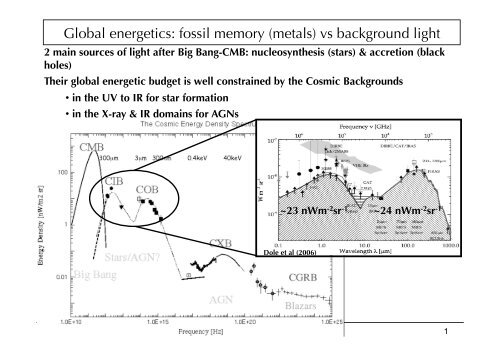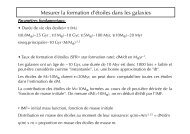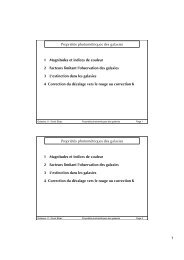Global energetics: fossil memory (metals) vs ... - David Elbaz
Global energetics: fossil memory (metals) vs ... - David Elbaz
Global energetics: fossil memory (metals) vs ... - David Elbaz
You also want an ePaper? Increase the reach of your titles
YUMPU automatically turns print PDFs into web optimized ePapers that Google loves.
<strong>Global</strong> <strong>energetics</strong>: <strong>fossil</strong> <strong>memory</strong> (<strong>metals</strong>) <strong>vs</strong> background light<br />
2 main sources of light after Big Bang-CMB: nucleosynthesis (stars) & accretion (black<br />
holes)<br />
Their global energetic budget is well constrained by the Cosmic Backgrounds<br />
• in the UV to IR for star formation<br />
• in the X-ray & IR domains for AGNs<br />
~23 nWm -2 sr -1<br />
Dole et al (2006)<br />
~24 nWm -2 sr -1<br />
<strong>David</strong> <strong>Elbaz</strong> 1
Budget énergétique<br />
L'énergie de liaison par nucléon de<br />
l'hélium est de 7MeV/nucléon. Celle du<br />
fer-56, le noyau d'atome le plus « soudé »<br />
n'est pas beaucoup plus élevée, avec 8.8<br />
MeV/nucléon.<br />
Une étoile passe la plus grosse fraction de<br />
son temps à convertir de l'H en He. Cette<br />
réaction est la principale source de<br />
lumière stellaire dans l'univers.<br />
Nucléosynthèse: p -> He -> C, N, O,…<br />
m p = 0.93828 GeV<br />
m n = 0.93857 GeV<br />
Energie de liaison H -> He: 7 MeV<br />
Lorsqu’un p -> He<br />
il produit 7MeV par unité de 0.93828 GeV<br />
Donc :<br />
0.74 % de la masse est convertie en lumière<br />
He -> C, N, O: only gains 0.5 MeV<br />
<strong>Global</strong>ement le budget de la nucléosynthèse est :<br />
Energie rayonnée = 0.007 x masse de « métaux » x c 2 [ Joules ]<br />
par unité de temps, quand dM « métaux » sont produits en dt :<br />
Luminosité rayonnée = d [ 0.007 M Z c 2 ] / dt<br />
Galaxies J1 - <strong>David</strong> <strong>Elbaz</strong> Fond diffus extragalactique Page 2
En réalité les « métaux » sont ici constitués de l’He non primordial et des métaux classsiques<br />
(C,N,O,Fe principalement).<br />
La masse du proton et du neutron est de ~0.94 GeV, donc l'énergie de liaison rayonnée au cours de<br />
la fusion d'un proton pour donner de l’He est de 7MeV/0.94GeV=0.74% de sa masse<br />
(m p = 0.93828 GeV, m n = 0.93857 GeV), i.e. E = dM c 2 .<br />
La plupart de l’hélium est d’origine primordiale mais une partie a été générée par la nucléosynthèse<br />
stellare. La valeur primordiale est de Y p =M He /M totale =0.24, mais on observe dans le Soleil Y =0.28,<br />
donc ΔY=0.04 ont été générés par les étoiles.<br />
Dans le voisinage solaire, la métallicité est de Z=M métaux /M totale =0.02 avec :<br />
~60% d’oxygène (8 meV), ~7% de fer (8.6 MeV) et le reste de C,N principalement (7.5 MeV),<br />
ce qui fait un taux équivalent de ~ 7.9 MeV , i.e. 0.84 % (/0.94GeV).<br />
<strong>Global</strong>ement, sur 1 kg de masse stellaire dans l’univers local, il y a donc 4% d’He non primordial et<br />
2% de métaux, qui ont donné lieu à de la lumière. La quantité totale de lumière ainsi produite est:<br />
He: 4% de 1 kg sont convertis en lumière avec une efficacité de 0.74%= 30 gr x c 2 .<br />
Métaux: 2% de 1 kg sont convertis en lumière avec une efficacité de 0.84%= 17 gr x c 2 .<br />
<strong>Global</strong>ement, 0.0074*0.04+0.0084*0.02= 0.0464% de la masse est convertie en lumière<br />
1 Joule = 1 kg m 2 s -2 , donc on a 47 x 10 -3 x (3x10 8 ) 2 = 4.2x10 13 Joules/kg d’étoiles<br />
Galaxies J1 - <strong>David</strong> <strong>Elbaz</strong> Fond diffus extragalactique Page 3
Validation du raisonnement à l'échelle de la Voie Lactée<br />
<strong>Global</strong>ement: 0.0464% de la masse est convertie en lumière (E=mc 2 )<br />
Dans le cas de la Voie Lactée: M * =7.8x10 10 M 6.5x10 54 Joules (M =2x10 30 kg)<br />
Si on suppose que cette énergie a été produite en continu sur les 12 Gyr d’âge de la V.L.:<br />
L = 6.5x10 54 Joules / 31 556 926 sec= 1.72x10 37 W= 4.55x10 10 L (L = 3.826x10 26 W)<br />
Or L bande I (V.L.)=(3.8±0.6)x10 10 L !!! (Flynn et al. 2006, MNRAS 372, 1149)<br />
Galaxies J1 - <strong>David</strong> <strong>Elbaz</strong> Fond diffus extragalactique Page 4
Le fond diffus cosmologique<br />
A l’échelle de l’univers:<br />
1. Mesurer la quantité d’He et de métaux par unité de volume (Mpc 3 ) de l’univers local:<br />
ρ métaux ~ 2.5 x 10 -30 kg m -3 et ΔY=0.04=2Z =>ρ He ~ 5 x 10 -30 kg m -3<br />
ETOILES<br />
Les baryons sous la forme d'étoiles (+ restes stellaires) constituent une proportion d'étoiles (+ restes stellaires) de:<br />
Ωbulbes = ρbulbes /ρc ~ 0.002600 h-1 (Fukugita, Hogan, Peebles 1998)<br />
Ωdisques = ρdisques /ρc ~ 0.000860 h-1 Ωirrégulières = ρirrégulières /ρc ~ 0.000069 h-1 où: Ω=ρ/ρc avec ρc = 9.47 x 10-27 kg m-3 = 3H 2<br />
0 /(8πG)<br />
(H0 =71 km s-1Mpc-1 ; G=6.67x10-11 m3 kg-1 s-2 ; h=H0 /100=0.71)<br />
ρ bulbes ~ 3.5 x 10 -29 kg m -3 , avec Z bulbe ~2 x Z = 0.04 => ρ bulbes métaux ~ 14.0 x 10 -31 kg m -3<br />
ρ disques ~ 1.1 x 10 -29 kg m -3 , avec Z disques ~1 x Z = 0.02 => ρ disque métaux ~ 2.3 x 10 -31 kg m -3<br />
ρ irrégulières ~ 0.09 x 10 -29 kg m -3 , avec Z irrégulières ~ 0.02 => ρ irrégul métaux ~ 0.2 x 10 -31 kg m -3<br />
=> ρ * galaxies métaux ~ 1.8 x 10 -30 kg m -3<br />
MILIEU INTERGALACTIQUE<br />
Milieu intergalactique dans les amas de galaxies= milieu intra-amas: Ω ICM = ρ ICM /ρ c ~ 0.0026 h -1<br />
Où Z ICM =0.3 x Z = 0.006 => ρ ICM métaux ~ 2.1 x 10 -31 kg m -3<br />
Milieu intergalactique dans les groupes de galaxies= milieu intra-groupes: Ω groupes = ρ groupes /ρ c ~ 0.0056 h -1<br />
Où Z ICM =0.3 x Z = 0.006 => ρ groupes métaux ~ 4.5 x 10 -31 kg m -3<br />
=> ρ intergalactique métaux ~ 0.7 x 10 -30 kg m -3<br />
=> ρ m (métaux) ~ 2.5 x 10 -30 kg m -3<br />
Galaxies J1 - <strong>David</strong> <strong>Elbaz</strong> Fond diffus extragalactique Page 5
The local cosmic metal density<br />
• From previous considerations, we get:<br />
ρ Z = 25 x 10 -31 kg m -3<br />
• Calura & Matteucci (2004, MNRAS 350, 351) :<br />
ρ Z<br />
= 9.37 x 10 6 M Mpc -3<br />
= 9.37 x 10 6 x 1.989 x 10 30 / (3.0856 x 10 22 ) 3 kg m -3<br />
• Mushotzky & Lowenstein (1997) :<br />
ρZ = 6.34 x 10 -31 kg m -3<br />
ρ Z = 1.4 x 10 7 M Mpc -3 = 9.5 x 10 -31 kg m -3<br />
• Zepf & Silk (1996) :<br />
ρ Z = 4 x 10 7 M Mpc -3 = 27 x 10 -31 kg m -3<br />
• Madau et al. (1996) :<br />
ρ Z = 5.4 x 10 6 M Mpc -3 = 3.7 x 10 -31 kg m -3<br />
• So globally, we get :<br />
ρ Z = [4 - 27] x 10 -31 kg m -3 = [ 1.5±1.1 ] x 10 -30 kg m -3<br />
Galaxies J1 - <strong>David</strong> <strong>Elbaz</strong> Fond diffus extragalactique Page 6
Le fond diffus cosmologique<br />
1. Mesurer la quantité d’He et de métaux par unité de volume (Mpc 3 ) de l’univers local:<br />
ρ métaux ~ 2.5 x 10 -30 kg m -3 (cf diapo suivante) et ΔY=0.04=2Z =>ρ He ~ 5 x 10 -30 kg m -3<br />
2. En déduire la quantité totale de lumière produite par unité de volume :<br />
ρ L = ρ lum x c 2 [ J m -3 ] où ρ lum =[0.0074 x ρ He + 0.0084 x ρ métaux ]<br />
3. Sur Terre, on mesure un fond diffus par u. de surface et par stéradian: en W m -2 sr -1 .<br />
C e f o n d n o u s a r r i v e s u r l a t o t a l i t é d u c i e l = 4 π<br />
stéradians : ε L =ρ lum x c 2 / 4π [ J m -3 sr -1 ]<br />
4. La lumière nous arrive à la vitesse « c », donc sur une surface collectrice de 1 m 2 on<br />
r e ç o i t l a l u m i è r e c o n t e n u e d a n s « c » m 3 p a r s e c o n d e :<br />
I= ρ lum x c 3 / 4π [ W m -2 sr -1 ]<br />
5. Mais on mesure hν observé , ce qui est émis est hν emitted : hν obs = hν em /<br />
(1+z em ) I= ρ lum x c 3 / (4π x (1+z) ) [ W m -2 sr -1 ] du fait de l’expansion<br />
I= [0.0074x5x10 -30 +0.0084x 2.5x10 -30 ]x(3x10 8 ) 3 /(4πx(1+z))= 125/(1+z) [nW m -2 sr -1 ]<br />
Si on suppose que le redshift moyen d’émission est de z~1 -> I ~ 62 [nW m -2 sr -1 ]<br />
Pour la valeur moyenne de ρ métaux ~ (4 - 27) x 10 -31 kg m -3 : I ~ 40 ± 30 [nW m -2 sr -1 ]<br />
Galaxies J1 - <strong>David</strong> <strong>Elbaz</strong> Fond diffus extragalactique Page 7
Comparaison au fond diffus mesuré…<br />
On a vu que : I= ρ lum x c 3 / (4π x (1+z) ) [ W m -2 sr -1 ]<br />
125/(1+z) [ nW m -2 sr -1 ]<br />
où z est le redshift typique auquel les éléments<br />
ont été formés.<br />
Si on suppose que le zmoyen d’émission z~1 :<br />
I ~ 62 [ nW m -2 sr -1 ]<br />
EN prenant en compte, l’incertitude sur la densité<br />
de métaux I ~ 40 ± 30 [ nW m -2 sr -1 ]<br />
~23 nWm -2 sr -1<br />
Dole et al (2006)<br />
~24 nWm -2 sr -1<br />
Le fond diffus cosmologique nous donne une idée du budget total de l'énergie rayonnée au cours<br />
de l'univers.<br />
On constate que celui-ci est du même ordre de grandeur que l'énergie qui a été rayonnée par les<br />
étoiles dans l'univers pour produire la quantité de métaux observés.<br />
Galaxies J1 - <strong>David</strong> <strong>Elbaz</strong> Fond diffus extragalactique Page 8
La masse des Trous Noirs Supermassifs au centre des galaxies est<br />
fortement liée aux propriétés de la galaxie-hôte<br />
M BH ~2x10 -3 x M * bulbe<br />
M BH = 1.5x10 8 σ 200 4 M <br />
où σ 200 =σ/200 km s -1<br />
Marconi & Hunt Tremaine et al.<br />
Gebhardt et al. (2000), Ferrarese & Merritt (2000) c.f. Magorrian (1998)<br />
Galaxies J1 - <strong>David</strong> <strong>Elbaz</strong> Fond diffus extragalactique Page 9
<strong>Global</strong> <strong>energetics</strong>: <strong>fossil</strong> <strong>memory</strong> (<strong>metals</strong>) <strong>vs</strong> background light<br />
Contribution of "Black Holes" to the cosmic background light:<br />
M BH ~ 2x10 -3 x M * (bulges) & ρ bulges ~ 3.5 x 10 -29 kg m -3<br />
=> ρ BH ~ 4.6 [-1.4,+1.9] x 10 -32 kg m -3 (Marconi & Hunt 08)<br />
Gravitational accretion (SMBH growth) converts mass into light with an efficiency of<br />
η~5-10 % & IGL SMBH = η x ρ BH c 3 / (4π x (1+z)) = 9±5 /(1+z) nW m -2 sr -1<br />
For z~1, we get : IGL SMBH ~ 5±3 nW m -2 sr -1<br />
To be compared to: IGL nucleosynthesis ~ 40±30 nW m -2 sr -1<br />
Per unit mass accretion is 10 times more efficient than nucleosynthesis (~7% <strong>vs</strong> 0.7%)<br />
But on average nucleosynthesis produces 10 times more energy than accretion.<br />
~23 nWm -2 sr -1<br />
Galaxies J1 - <strong>David</strong> <strong>Elbaz</strong> Fond diffus extragalactique Page 10<br />
Dole et al (2006)<br />
~24 nWm -2 sr -1<br />
0.1 nW m -2 sr -1
Le Borgne et al. (2009)<br />
Cosmic history of star formation <strong>vs</strong> accretion<br />
Wang et al. 08<br />
Galaxies J1 - <strong>David</strong> <strong>Elbaz</strong> Fond diffus extragalactique Page 11
~23 nWm -2 sr -1<br />
Dole et al al (2006)<br />
~24 nWm -2 sr -1<br />
<strong>Elbaz</strong> et al (2002)<br />
Galaxies J1 - <strong>David</strong> <strong>Elbaz</strong> Fond diffus extragalactique Page 12
Stacked MIPS 70 µm (25mJy-3σ) images on 24µm (80µJy-3σ) priors<br />
confirms that > 2/3 of CIRB (peak) is resolved in galaxies Dole et al. (2006)<br />
IGL(70µm)= 5.4 nW m -2 sr -1<br />
~ 83% EBL(70µm) [6.4 nW m -2 sr -1 ]<br />
IGL(160µm)= 10.2 nW m -2 sr -1<br />
~ 66% EBL(160µm) [15.4 nW m -2 sr -1 ]<br />
Larger λ dominated by larger redshifts !<br />
Galaxies J1 - <strong>David</strong> <strong>Elbaz</strong> Fond diffus extragalactique Page 13
IRAS : 57 cm<br />
The far infrared Universe: from Spitzer to Herschel<br />
ISO : 60 cm<br />
Spitzer : 85 cm<br />
Discovery of luminous IR galaxies, >90% of light in IR<br />
Dominate the bright-end of the luminosity function<br />
Mostly major mergers…<br />
Space density of LIRGs x70 at z~1<br />
They dominate the SFR density at z>0.7<br />
Extrapolation to far IR bulk of the IR background / LIRGs<br />
Galaxies J1 - <strong>David</strong> <strong>Elbaz</strong> Fond diffus extragalactique Page 14
Sensitivity limits of IR surveys at the Spitzer era<br />
Galaxies J1 - <strong>David</strong> <strong>Elbaz</strong> Fond diffus extragalactique Page 15<br />
2 mJy
2.6’<br />
3.6µm<br />
25 hrs<br />
0.8"<br />
24µm<br />
10.9 hrs<br />
5.6"<br />
70µm<br />
2.9 hrs<br />
16"<br />
Galaxies J1 - <strong>David</strong> <strong>Elbaz</strong> Fond diffus extragalactique Page 17
Galaxies J1 - <strong>David</strong> <strong>Elbaz</strong> Fond diffus extragalactique Page 18
IRAS : 57 cm<br />
The far infrared Universe: from Spitzer to Herschel<br />
ISO : 60 cm<br />
Spitzer : 85 cm<br />
Discovery of luminous IR galaxies, >90% of light in IR<br />
Dominate the bright-end of the luminosity function<br />
Mostly major mergers…<br />
NEW ISSUES HAVE APPEARED on galaxy formation/evolution:<br />
• violent <strong>vs</strong> quiescent star formation (SFR-M*,…): duty cycle ?<br />
• origin of the « IR downsizing » : internal/external ?<br />
• does the environment trigger or quench SF ? Or none ?<br />
• are the CIRB/<strong>metals</strong>-SFR-M*densities consistent ?<br />
Space density of LIRGs x70 at z~1<br />
They dominate the SFR density at z>0.7<br />
Extrapolation to far IR bulk of the IR background / LIRGs<br />
• Stacking in far IR resolve peak IR bkg<br />
• Increasing density LIRGs/ULIRGs up to z~2<br />
• Large Sp fraction<br />
• Trace large-scale structures in formation<br />
• identify missing Compton Thick AGN<br />
Herschel: 350 cm<br />
<strong>David</strong> <strong>Elbaz</strong> 19
Near future: Herschel (followed by ALMA, JWST)<br />
Will probe the peak of the FIR emission<br />
--> Complete census on cosmic SFR history up to z~3<br />
Will not suffer from AGN contamination to derive SFR<br />
Access to the more distant universe<br />
MIR-FIR photometric redshifts to probe distant obscurded galaxies<br />
--> Are there lots of dust obscured star forming galaxies at high z ? ( Bouwens et al)<br />
Galaxies J1 - <strong>David</strong> <strong>Elbaz</strong> Fond diffus extragalactique Page 20
HERSCHEL<br />
Wilson, <strong>Elbaz</strong> 07 ESO-report<br />
Galaxies J1 - <strong>David</strong> <strong>Elbaz</strong> Fond diffus extragalactique Page 21
Hasinger ‘00<br />
300µm 3µm 300nm 0.4keV 40keV 4MeV 400MeV<br />
15µm (<strong>Elbaz</strong> et al. 02)<br />
CGRB<br />
Blazars<br />
Galaxies J1 - <strong>David</strong> <strong>Elbaz</strong> Fond diffus extragalactique Page 22
Hasinger ‘00<br />
300µm 3µm 300nm 0.4keV 40keV 4MeV 400MeV<br />
obscured AGNs<br />
Compton thin<br />
unobscured AGNs<br />
Compton Thick AGNs<br />
Gilli et al.<br />
CGRB<br />
Blazars<br />
Galaxies J1 - <strong>David</strong> <strong>Elbaz</strong> Fond diffus extragalactique Page 23
Spitzer-24µm<br />
"GOODS"<br />
Daddi et al. 2007<br />
The role of Active Galactic Nuclei<br />
normal galaxies 24µm-excess sources<br />
Chandra "stacking"<br />
Galaxies J1 - <strong>David</strong> <strong>Elbaz</strong> Fond diffus extragalactique Page 24




